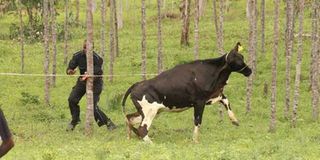Kwale County dairy project uplifts lives in rural areas

A Mnyalatsoni farmer struggles to control one of the heifers distributed by Governor Salim Mvurya. From a humble beginning three years ago, the dairy project is transforming lives in rural Kwale. PHOTO | WACHIRA MWANGI | NATION MEDIA GROUP
What you need to know:
- A similar number of heifers was given to women groups in other villagers in May 2015.
- Agriculture, Livestock and Fisheries Executive Joanne Nyamasyo said 36 heifers were distributed to farmers, mostly women.
- Agriculture and extension officers have trained farmers on artificial insemination services and many cattle dips have been rehabilitated.
From a humble beginning three years ago, a dairy project is transforming of lives in rural Kwale.
And on Wednesday, Governor Salim Mvurya distributed 20 more heifers to women groups in Mnyalatsoni Village, Kubo South Division. Some beneficiaries were widows.
A similar number of heifers was given to women groups in other villagers in May 2015.
“I got a cow last year and it gave birth a month later. Since that time, the life of my family has changed,” Ms Mary Mwasa from Majimboni Village said during the latest ceremony to distribute heifers.
She said she usually gets 12 litres of milk every day — six in the morning and another six in the evening — from her cow.
“My family now takes better tea for breakfast and our health has greatly improved. We also make yoghurt and fermented milk,” she said.
A litre of milk goes for Sh75, earning Ms Mwasa at least Sh150 every day.
The money helps offset costs for uniform and other requirements for her children.
Other basics such as tea leaves, salt and sugar are taken care of too.
The extra resources are put to other uses like tilling and weeding the land.
The story is repeated across the region once ravaged by malnutrition.
36 HEIFERS DISTRIBUTED
Agriculture, Livestock and Fisheries Executive Joanne Nyamasyo said 36 heifers were distributed to farmers, mostly women, when the project kicked off in the 2014-2015 financial year.
Tsimba-Golini Ward got 18 heifers while the rest were given to farmers in Mkongani.
“In the 2015-2016 financial year, we distributed 60 heifers to Mkongani, Kubo and Pongwe-Kikoneni/Dzombo wards,” she said.
The heifers are crossbred from Ayshire and Friesian.
Ms Nyamasyo said crossbreeds were suited for the region “since pure breeds are difficult to manage and our farmers do not have the necessary experience and knowledge.”
“Pure breed animals are also not suited for this hot climate. The animals die of heat or diseases,” she said.
A cow can be milked for nine months continuously before it gives birth.
MEET BASIC COSTS
Ms Nyamasyo said if taken care of properly, a cow could produce between 12 and 24 litres of milk per day.
The county governmrnt is meeting the basic costs of the project until the farmers “will be in a position to do so.”
She said the county would soon have a pure breed suited for local conditions.
“The national dairy project collapsed many years ago, affecting farmers. We saw it fit to reintroduce it,” she said.
Agriculture and extension officers have trained farmers on artificial insemination services and many cattle dips have been rehabilitated.
Locals are also trained on how to use drugs supplied by the county government as the area is infested with ticks and tsetse flies.
Rift Valley fever and foot and mouth diseases are also common.





